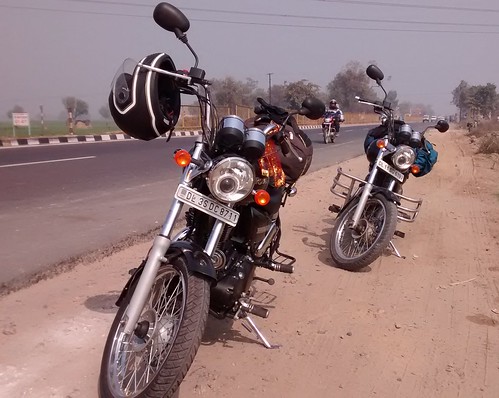This post is about the third day of my road trip from Delhi to Pune via Madhya Pradesh. Read about Day 2 here.
Panna to Vidisha, Bheemkund, Chinese Food
We woke up early and got ready to leave. We stopped at the first tea stall that we came across. It is a necessity one cannot easily do without. As we sat down to wait for the tea, one of the locals sitting there struck up a conversation with BBC. It started with a “Where are you coming from?” and went on with the usual questions about the number of kilometers travelled, what all we had covered on the way, how many days did it take us this far, what was the route forward, and, of course, what is the mileage of our bikes. We sat sipping our teas and enjoying the conversation. We started comparing lives in metros versus the smaller cities like Panna. He told us that got ready for office 30 minutes before the time he was due in office. Unlike the metros, the traffic did not consume a major chunk of the day’s hours. Then we discussed about the lack of water in the waterfalls around. He told us that the last season had seen very little rain. I asked him about the primary occupation of people in these parts. There was very little agriculture. It was mostly government jobs or mining for precious stones. Agriculture was not a very prominent or lucrative profession in these parts.
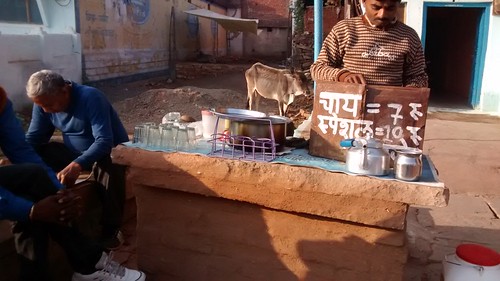 Morning tea in Panna
Morning tea in Panna
We paid for our tea and left for Chhatarpur, crossing the Panna Tiger Reserve and the dug up road between Ken and Khajuraho. We stopped for some breakfast at Chhatarpur. I finally found some poha and dug in. BBC gorged on samosas and poha without discrimination. Here again we met a gentleman who expressed interest in our bikes and travel. He was somewhat frustrated with the traffic sense of MP himself but his problem was that people here turned without giving an indication and were ready to fight when rebuked. I would have told him that it was the same across the country, but instead, I remarked on the wrong side driving in fast lanes. He laughed as it it was not as big a deal as compared to his woe. We left after breakfast and continued on the road to Bhopal.
We had planned to reach Sanchi before sundown and see the Great Stupa before halting in Bhopal for the night. But as we were riding down the road from Chhatarpur, which was much better than the road from Panna, I saw a board that marked distances to Jatashankar and a certain Bheemkund. I knew about Jatashankar as one of the Jyotirlingas, but it was too far off the highway. Bheemkund, though seemed only a short distance off the main road and we decided to go take a look. We did not have much expectation from the place since we were taking a random detour and the road inwards from the highway was 12 kilometers of unconstructed road. It took us the better part of a half hour to reach a small complex that evidently did not see much tourist activity. A few shops lay siege to the entrance. Of these, an enterprising shop-owner beckoned us and asked us to park the bikes next to his shop. We did so and he offered us to leave our luggage in his shop. We thanked him and took him up on the offer. Then he proceeded to tell us about the Bheemkund.
While on their exile, the Pandavas and their shared wife, Draupadi, were crossing these parts when suddenly Draupadi felt thirsty. With no source of water nearby, she taunted her husbands that it would be a shame for her to die of thirst despite having five superhuman husbands. Bheem, in his anger, banged his mace into the ground and the earth crumbled to form a pool. Arjuna unleashed his arrow which pierced the underworld to release water that filled the pool.
Why is it called Bheemkund and not Arjunkund is not explained. Both of them seemed to have played an equal role in creating the pool. Probably Bheemkund sounds cooler than the other option.
We drank a cup of tea, took a change of clothes and bought some pooja-samagri from the shopkeeper, more because we wanted to give him some business rather than our interest in pleasing the gods with incense. Sure enough, there was a Laxmi Narayan temple right up front. And a Vaishno Devi temple built on top of the hill. The Vaishnavites tend to lay claim to every place of significance and dazzle with their gaudiness. A small arrow proclaimed a Shiva temple somewhere on the walls of the Laxmi Narayan temple. Shiva does not need huge buildings to reside in. He is one with every piece of rock that you might wish to worship; he is nature itself.
Bheemkund was down a flight of stairs, inside a cave. We went in and the scene changed suddenly. The bright sun was gone and our eyes took a little time to adjust. The cave gave out a very prominent smell of bat droppings. The floor was paved with red stones and water dripped from the ceiling and created wet patches all over the place. We stepped carefully, not wanting to slip down the wet stairs. Down below we could see a group of people gathered around and sure enough, a few more steps made the Bheemkund visible to us.
A bunch of boys were swimming and diving in it’s clear blue waters. The kund was not huge and was lit by a skylight right above it. It extended to the far end of the cave. On this side there were two more Shiva temples. There were pipes descending into the pool, probably to draw water out of it. The water looked inviting and the boys seemed to be having fun, so we decided to join them and quickly got rid of our clothes. The only problem : neither of us was a good swimmer. I let BBC go in first. He idled on on side of the pool for quite some time, asking the boys about the depth of the kund. They told him that it was deep. So deep that the bottom was unknown. The shopkeeper outside had even told us that any kind of earthquake or volcanic activity in any part of the world was observed here as well. One of the boys told me that people from National Geographic had come to measure the depth of the pool and went away without an answer. How much of all this was fact or fiction was uncertain but it sure was interesting. However, the fact remained that the pool was deep enough to drown us. BBC took the leap of faith. He tried swimming to the other side, failed to grab the rock and was helped by the boys up. He came out with a smile on his face. My turn! I took a dip on my side and then swam to the other side. The length was not much and I could easily complete it in a couple of strokes. Had I been required to stop mid way for any reason, well, it would have not been pretty!
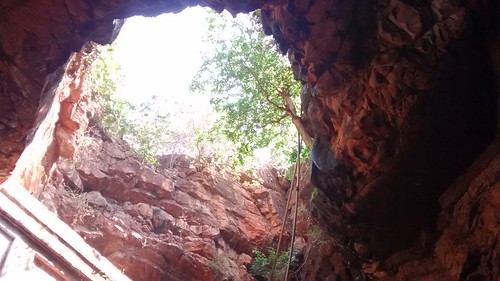 The skylight over Bheemkund
The skylight over Bheemkund
We spent close to an hour at Bheemkund. It was a delightful find. We swam in the water some more. I noticed some shampoo sachets floating around but the water wasn’t dirty. It had a slightly sweet taste to it as well. The shopkeeper outside later told us that this was another miraculous aspect of the pool. Even in melas, when thousands thronged to bathe in the pool, the water never got dirty! I talked to the boys, asked them where they were from. Most were from a cement plant nearby and one had come from Bhopal. I asked them how much time would it take to Sanchi; 5 hours, they said. And another hour to Bhopal thence. Finally, we got out of the water, dried and changed, put the pooja-samagri to use and came out of the cave. A sign proclaimed that swimming in Bheemkund was dangerous. Well, too late now.
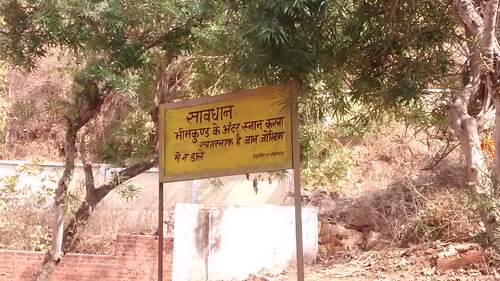 Warning!
Warning!
We went back outside and had another couple of cups of tea. For the lack of a good option for food, we decided to hit the highway and stop at a dhaba. We went back and sat at the shop where our luggage was dumped. The shopkeeper told his story this time; of how he had lost his ability to stand. He was stricken with partial paralysis since birth and the ailment aggravated with each passing year till it consumed his legs. Even his left hand was not completely functional. But this man had the spirit of a fighter. “Better to die than to beg!” he said. I told him the country needed more like him. People had gotten used to freeloading here. We said our goodbyes and he told us to come back sometime. I answered in the affirmative and we offroaded our way back to the highway. Immediately after, we saw a dhaba and sat down to have some delicious lunch of dal and sev tamatar with rotis.
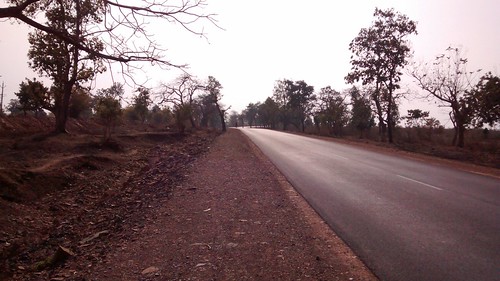 Beautiful highways of Madhya Pradesh
Beautiful highways of Madhya Pradesh
It was half past three in the afternoon by the time we resumed our journey on the road. 5 hours to Sanchi would mean 8:30 PM. We realised the reality and discussed our options over another cup of tea further down the road. The sun was about to set and it would take us at least a couple of hours to get to Bhopal. And it would be utterly pointless since the next day we would have to drive 40 kilometers back to see the Stupa. We decided to put up in Vidisha instead.
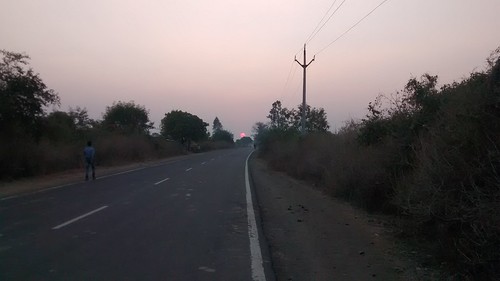 Sun sets over the highway
Sun sets over the highway
The roads were good and the sun set in our line of sight. Once the red ball of fire slowly departed from the skies, darkness started claiming the land. We switched on the headlights some 30 kilometers out of Vidisha. Needless to say, the incoming glare troubled me greatly but since the roads were good, we managed to make it to Vidisha in good time. BBC wanted to eat some chaat and we stopped at a paani poori walah and had a plate each. Then we went to the egg stall next to it and ordered a plate of anda bhurji (spiced up scrambled eggs). We inquired about lodging options and were pointed towards the railway station. After filling our stomachs with the burji, we went to the recommended lane. The first guest house was a certain Hotel Roshan Residency. It seemed way better than the one we had taken in Jhansi, though on a bit upper side of our budget. Still, we went for it and settled down for the night.
After a quick bath we went to the other side of the railway station for dinner after dropping our bikes in the station’s parking. The other side was the main market. There were a lot of shops and a couple of temples immediately visible. We felt like having something different so we went into a shop that advertised Chinese food. The food was passable but we filled ourselves up and walked back to the hotel. It had been a long day; almost 400 kilometers on a mixed quality of roads. The trip meter read 1138. It was time to watch some old songs on the TV and wait for sleep to appease us with it’s comforting embrace.
[Read about Day 4 and 5 here.](/post/delhi-pune-finale/)
Here is the route taken on Day 3 on Google Maps.
And here is a complete album of the road trip.
